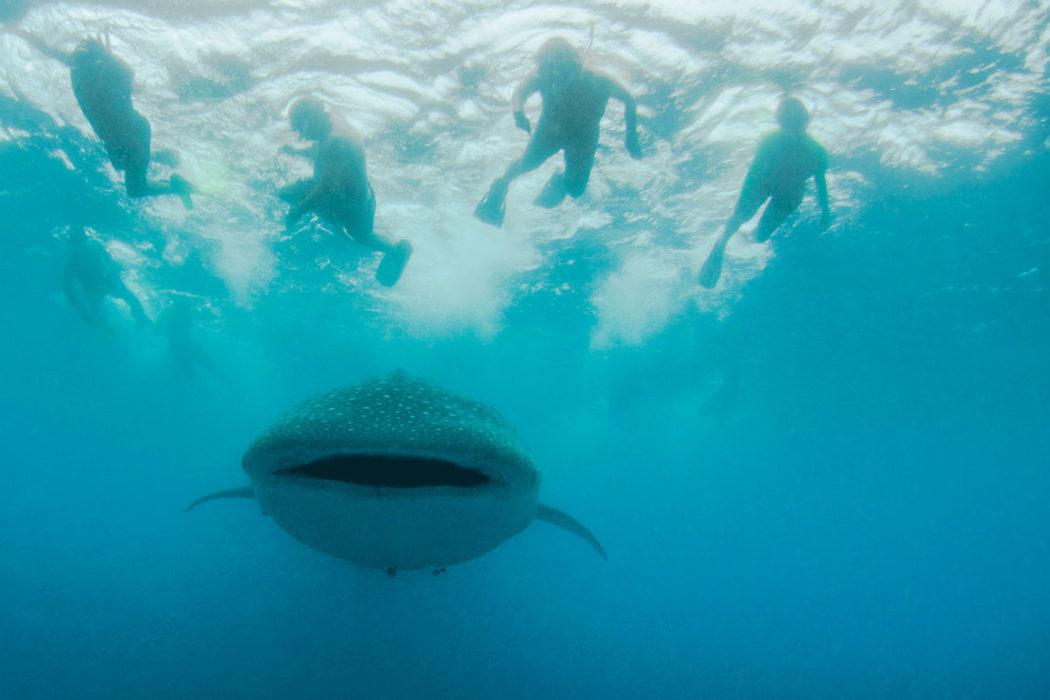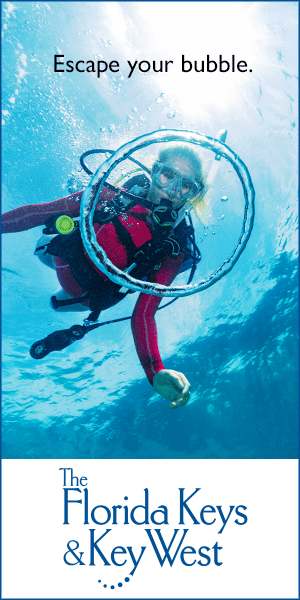As a diver, I’m often asked what has been my most memorable dive. Of course, like many experienced divers who’ve been at it for years, it’s impossible for me to cite a single experience. But I do have a short list. They all share one common denominator — some special interaction with marine wildlife. Whether it involved a whale or a pygmy seahorse, my most fulfilling experiences were those that allowed me to get up close and personal with the creatures of the sea. If you’ve been fortunate enough to have similar experiences, like me, you probably consider them magical or even life-altering.
But what about these experiences from the non-human perspective? What are the consequences for the wildlife in question? Some contend that, when done appropriately, such encounters pose no problem, and in some cases, may be a pleasurable or at least an engaging experience for the nonhuman participant. Yet, these claims are merely inferences made by those who can hardly be called objective.
Of course, there’s another side of the story. At the extreme end are those who believe that all but the most benign human contact with wildlife is at best encroachment and at worst — a form of harassment. And as in all matters where people disagree, the continuum runs all the way to those who look at wildlife as mere instruments for human amusement. Most take a position somewhere between these two extremes.
Understanding issues where there are such divergent opinions requires first having a clear agreement on the terminology used to frame the discussion; and at the heart of this controversy is the question of what, exactly, constitutes “harassment.” For example, imagine that you’re on a boat and spot a whale, dolphin or manatee. As you change course to get a better look, the animal changes course as well, but in a direction distinctly away from your new path. Would the decision to change course yet again toward the animal constitute “following” or “chasing” it? Regardless of your perspective, there’s no easy or certain way to answer.
Even with the best of intentions not to “interfere,” the mere disturbance of wildlife, some contend, can result in changes in physiology, behavior, reproduction, population levels and even species composition within a community. This is why, in the U.S., marine mammals are protected from harassment under the provisions of the Marine Mammal Protection Act (MMPA) of 1972, while endangered species are further afforded protection under the Endangered Species Act (ESA) of 1973. Both formally define harassment, but in very general terms so that all affected species — from whales to bald eagles — are covered. But such broad definitions make enforcing actual policies on harassment very difficult.
Perhaps the best case of just how difficult defining harassment can be is exemplified by a situation known to almost every diver in America. In Crystal River, Florida, between 600 and 800 endangered West Indian manatees now migrate to the river’s source, Kings Bay, each winter to find protection from the cold in the constant 72 degree Fahrenheit (22 degrees Celsius) water of the main and surrounding springs. Close on their heels each year more than 100,000 tourists show up, many looking not only to observe the docile giants but eager for an in-water “encounter.”
Ask many of those who have had an opportunity to swim with manatees and you’ll likely hear the encounter described as a once-in-a-lifetime experience. Participants often touch, pet and interact in ways that are tough to call anything other than “play” (which is currently legal provided the animal approaches the diver and is not pursued). The question, of course, to those responsible for managing the manatees is: When does what we deem play become harmful? In other words, when does interaction become harassment? The answer continues to be a subject of strong disagreement.
Opportunities to view and interact with marine animals aren’t restricted to manatees. In 2017 alone, approximately 20.35 million Americans participated in some form of wildlife viewing or interaction. It’s estimated that about one in five U.S. households take at least one trip a year to view wildlife (15 percent to engage specifically in marine mammal viewing). While the trend increases, scientific research into the effect of human encounters with wildlife lags behind. The issue is a complex one because of the difficulty in controlling factors like participant behavior, frequency, magnitude, timing and location of the activity in question. Studies are complicated further by characteristics of the wildlife, time of year, age, habitat type, and an animal’s level of tolerance to human activity. Studies have also shown that wildlife behavior, including preference for human interaction, can change over time.
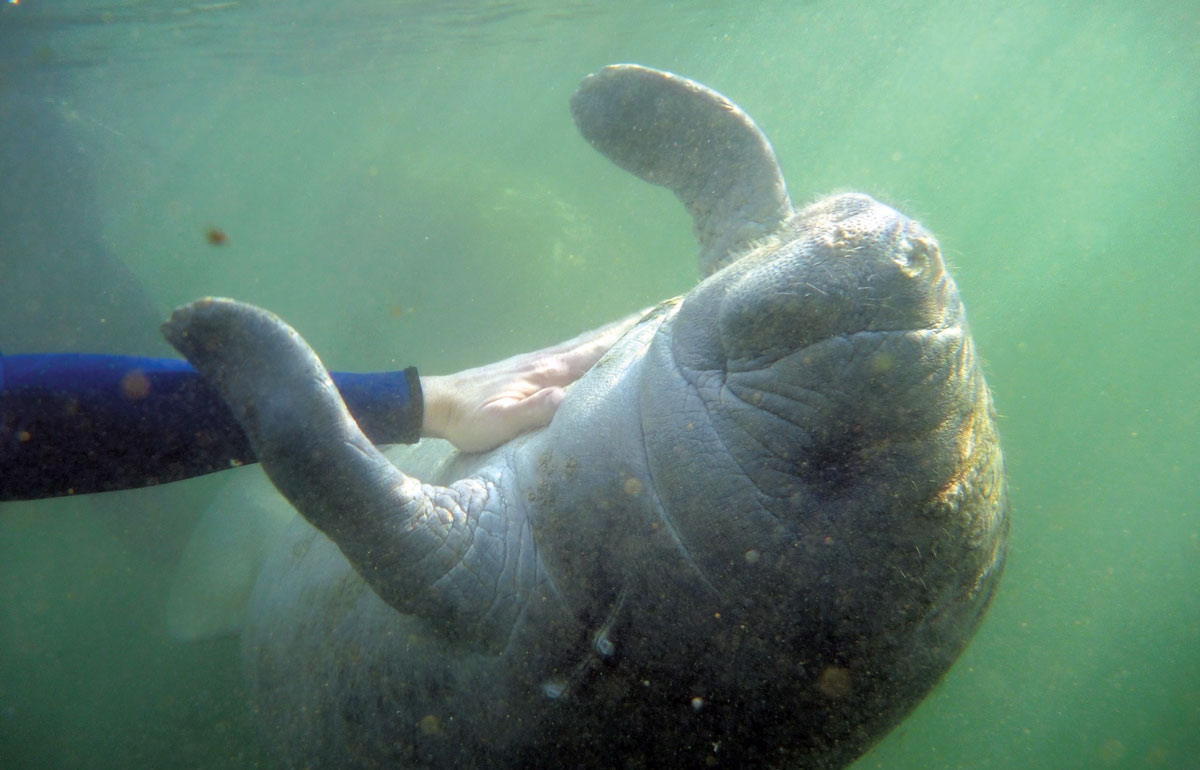
Under Florida law, touching a manatee is legal — provided the animal initiates the encounter. Pursuing, chasing or harassing a manatee is against the law.
Issues in Defining Harassment
Those who study human-wildlife interaction classify it in two ways. First, there are direct and indirect impacts. Direct impacts are viewed as “primary disturbances” from (direct) interactions with humans, while indirect impacts are disturbances to a species’ habitat. Impacts are also classified as selective and nonselective, meaning that the impacts result from activities that focus on the animal (selective) or result from recreational activities in which interactions occur incidentally (non-selective).
Direct impacts are the focus of this discussion — and researchers further define these as either harvest or harassment. Harvest includes hunting, fishing or other activities that actually remove the animal from the environment. While this is easy to understand, the concept of harassment is not so easily defined. And it’s this ambiguity that creates the conflicting viewpoint over wildlife interactions. For example, let’s consider a few formal definitions. Some view harassment as “any activity of man which increases the physiological costs of survival or decreases the probability of successful reproduction of wild animals.” Others contend that harassment is any human disturbance that “produces stressful situations for wildlife resulting in negative outcomes for an individual or species including excitement and/or stress, disturbance of essential activities, severe exertion, displacement and sometimes death.” (See the sidebar on legal definitions of harassment.)
What also makes the harassment issue problematic is the difficulty in determining when harm is done. Few animals exhibit behavior that can be unequivocally interpreted as a response to harassment — and some of the actions that may indicate disturbance can also be part of normal social behavior. So, while limited, what has the scientific research exploring harassment determined? Basically, it has shown that human interaction can affect individuals, populations and even entire communities of wildlife.
Clearly, we now know that direct harassment of wildlife can affect a behavior, reproductive success and the overall fitness of animals. This has been well-documented in the terrestrial environment with chimpanzees, elephants, rhinos, bears, jaguars and countless species of birds. Often the simple presence of people — either in vehicles or on foot — has been shown to affect the behavior of many animals.
Although not as well studied, similar concerns arise in viewing marine wildlife. There’s particular concern over the growing worldwide industry for observing, and sometime interacting with, marine wildlife such as whales and dolphins. In fact, more than 35 years of research has shown that human activities have caused whale species to change behavior. Hawaii is the epicenter of such research. There, studies have shown that vessel traffic is causing female humpbacks (Megaptera novaeangliae) and their calves to abandon certain areas. And the Hawaiian spinner dolphin (Stenella longirostris), too, has been negatively affected by irresponsible tourism operators and customers. Learning that the spinners use protected bays in Hawaii to rest and socialize, or remain out of reach of larger predators, tourism operators now regularly provide swim-with-dolphin tours. This appears to have permanently displaced some dolphins and may repeatedly disrupt the resting behavior of those that use these areas, causing reduced energy levels. As a result, both the state of Hawaii and the federal government are currently framing regulation to better control the situation. Along the east coast, off Panama City, Florida, interactions with Atlantic bottlenose dolphins (Tursiops truncatus) have habituated many of them to human presence. One study showed the dolphins spending 77 percent of their time interacting with humans, which substantially decreased their time spent foraging. From the other side of the equation, there have also been several cases of severe injuries to humans in swim-with-dolphin experiences.
What the Law Says About “Harassment”
Both the ESA of 1973 and the MMPA of 1972 prohibit the “take” of animals under their jurisdiction. Unlike what it may imply colloquially, “take” from a legal perspective doesn’t just mean “remove.” Its definition is much broader and includes harassing, harming, pursuing, hunting, shooting, wounding, killing, trapping, capturing or collecting protected animals.” But the two Acts also differ in their definitions of harassment. The ESA focuses on the potential for injury to an animal, while the MMPA divides harassment into two types: “Level A” harassment is defined as having the “potential to injure a marine mammal . . .in the wild.” “Level B” harassment is defined as having the “potential to disturb a marine mammal . . . in the wild.” On a state level, harassment is defined by the Florida Manatee Sanctuary Act (FMSA) of 1978 similarly to the way it’s defined under the ESA, except that it is specific to manatees and explicitly lists feeding as a harassing behavior.
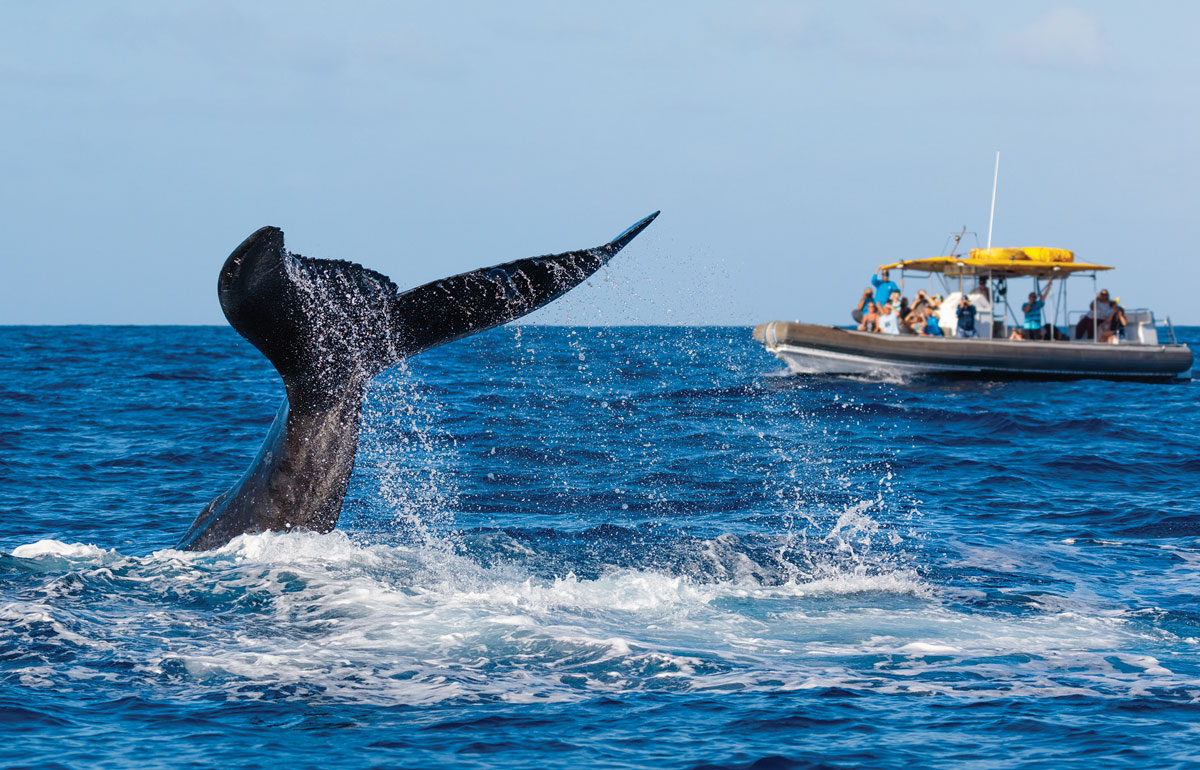
A responsible approach to wildlife interaction begins with adopting a responsible environmental ethic. This shift requires a new mindset where we no longer see ourselves as “customers” but as “guests.”
Is Consensus Possible?
One of the difficulties in understanding or coming to any common ground on the issue of harassment is that its definition is not only ambiguous, but fraught with value judgments. Various interest groups — tourism operators, conservation organizations and government regulators — impose their own values in interpreting and applying the definitions. This is complicated by the fact that clear evidence of negative impact is hard to detect. Add to this the difficulty in effective enforcement, and it’s easy to understand why there’s a high level of both concern and emotion over the harassment issue in all sectors of wildlife tourism, both marine and terrestrial.
As shown in the sidebar, the definitions of harassment found in the ESA and the MMPA are ambiguous, and thus open to a variety of interpretations when applied in the field. While no reasonable person disputes the need to control human-wildlife interactions and all agree that animals must be protected, each interest group interprets “harassment” based on their own values. Again, the situation in Crystal River is a classic example. There, the U.S. Fish and Wildlife Service (USFWS) is the primary management agency responsible for interpreting and applying the concept of harassment to manatee encounters. In doing so, they have interpreted the harassment definition in a way that permits participants to physically interact with manatees as long as the participants allow the manatee to dictate the encounter. And the USWFS interpretation is not restricted to Crystal River or to manatees, but is applied by them everywhere they have jurisdiction.
By contrast, as their mission is strictly the protection of wildlife, conservation groups often take a much stricter view. These values are reflected in how harassment is interpreted by the Save the Manatee Club (SMC), the primary manatee advocacy group in the United States. Their position is that the potential negative effects from manatee encounters exceed any benefit it provides the animals. So, they maintain that any physical contact component should be prohibited. In essence, any human interaction is harassment, even instances where someone is doing nothing more than making the manatee take an evasive maneuver. However, even SMC recognizes that there is a level of harassment that’s unavoidable (such as swimming over an animal one didn’t realize was present) and is, therefore, permissible.
Resolving Conflicts
Resource management problems like human-wildlife interaction are highly contentious and difficult to resolve largely because, as seen, the variables are so complex and scientific information is often incomplete. The situation virtually precludes any authority from saying, with any certainty, that one decision is right while another is wrong. This has led one researcher, Michael Sorice, to comment, “the issue of harassment is not a technical one but largely an issue of social value.…The specific meanings of …harassment must be articulated in a manner that provides clear consensus-based indicators of when harassment is occurring. At the same time, stakeholders must agree on what acceptable encounter practices are given current use patterns.”
Sorice and others who have studied the issue of human-wildlife interaction suggest that the first step in coming to common agreement on what exactly constitutes harassment is developing “best practices” for tour operators. These practices include prescribing guidance on factors such as vessel distance/maneuvering and, where appropriate, in-water participant behavior. In addition, best practice strategies can include agreements by tour operators for self-imposed limits, like restricting the number of boats and people at particular sites. This idea of self-imposed limits has, in fact, been used successfully in various wildlife encounter operations around the world. Furthermore, many researchers believe that, because baseline definitions for harassment in laws such as the ESA are so vague and applies to so many animals, what’s needed are refined definitions for specific species based on biological, ecological and social variables.
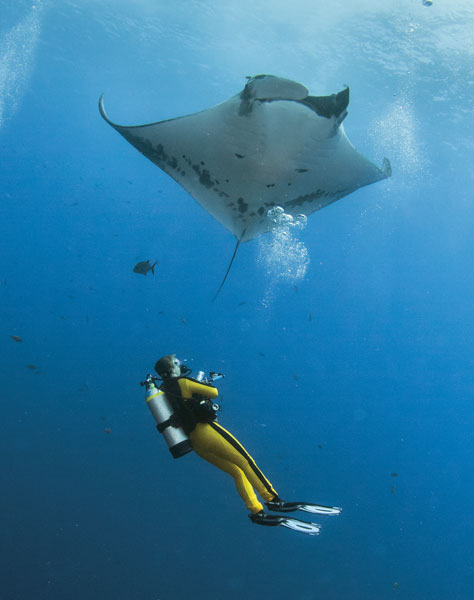 A New Perspective
A New Perspective
In examining all the controversy and disparate views on the subject, it seems that what’s needed most to address harassment in wildlife interaction is a change in attitude and perspective. A common claim by many wildlife encounter advocates is that “we do nothing that hurts the animal.” That may well be the case and certainly no reasonable person wants to do harm. But the reality is, because we’re in the water with the animals for only a very limited time, participants are actually in no position to make such an assessment. Perhaps there is no obvious harm done during the short time spent in the water or when observing the creature from the surface. But what about later?
As someone who works in the field of sustainable tourism, much of my time is spent with marine tourism professionals where the discussion often turns to responsible wildlife interaction. One strategy I use to better explain the potential of long-term negative effects on wildlife is, what I call, the “energy theft” concept. It goes like this: What fuels the activity of all living organisms is, of course, food. The energy derived from food drives all life processes such as growth, reproduction, finding food or escaping from predators. Whether it’s a fish, a squirrel or a human, we all share these common realities of life. However, humans differ from wildlife in many important ways. Specifically, we don’t have to worry too much about escaping predators and finding food — in most cases — means nothing more than a trip to the supermarket. When humans need more fuel, we simply buy it. Of course, this isn’t an option for non-humans.
To see how this applies to the harassment discussion, let’s pose a scenario: Suppose you’re swimming along a reef and encounter a large turtle. It shows no signs of fear, so it doesn’t try to escape. It’s an enormous beast, so you decide to grab on and let the turtle take you for a ride. Several minutes later, the two of you part company and the turtle swims off, seemingly unaffected by the encounter. Putting aside any ethical issues, and looking only at the practical consequences, what’s the harm? The turtle was uninjured, and, in fact, you see it a few days later obviously no worse for wear. Your conclusion: Riding turtles is harmless.
The problem is that our scenario is really an exercise in human self-deception or, less kindly, arrogance. Although the turtle wasn’t injured in any way, the experience did steal from it what could be argued as its most precious resource — energy. That energy stolen may have been inconsequential. But it just as easily may have been the tiny bit more energy needed to ward off a sickness, produce enough eggs for one of her hatchlings to survive or just the bit more speed to escape the jaws of a tiger shark. Viewed from this vantage point it could have been a costly ride, after all.
The example is, I hope, an extreme one, as no responsible diver today should even consider riding sea turtles. But how much different is that than grabbing hold of a manatee, just for a second, or continually pursuing a pod of whales or dolphins? Energy is energy, and whether it’s expended by a fearful flight response or a needless swim to escape unceasing curiosity, the end result is the same — in the end, energy stolen from an animal that could make a good deal of the difference. The point is, you’ll never know because by the time it might become important, you’re long gone.
A Framework for Responsible Interaction
A responsible approach to wildlife interaction begins with adopting a responsible environmental ethic. This shift requires a completely new mindset where we no longer see ourselves as “customers” but as “guests.” And the difference is more than semantics. For example, unlike customers, guests behave in ways that accommodate their host. Furthermore, guests respect and defer to their host and respect the local “culture,” whereas customers demand service and accommodation.
Once you adopt the “guest” attitude, the next step is how to put this new mind-set into action. First, there’s the simple stuff: Avoid touching or feeding wildlife. Next, always remember the “energy thief” concept. Continually ask yourself, is my interaction robbing significant energy stores from the animal that might have unintended consequences when I’m not around? In addition, learn enough about the behavior of the wildlife in question so you can recognize if the animal shows any signs of stress or avoidance. Obviously, stop what you’re doing or back off if you notice any such behavior. If you’re a photographer, don’t encourage inappropriate or stressful behaviors just to get “that shot.” And don’t be afraid to share your perspective with other divers and encourage thoughtful conversations about the issue.
In my years of working the sustainable tourism field I’ve come to accept human-wildlife interactions, provided one adheres to three vital criteria. First, the interaction must be a free choice of the animal. Like people, animals differ in their “personalities.” Some enjoy, and even seek out, interaction — while others want no part of it. Respect that choice. Secondly, the interaction shouldn’t alter the animal’s natural behavior. It should go without saying, the ocean’s creatures aren’t there for our entertainment and encouraging or forcing them to behave in ways that aren’t part of their normal repertoire can never be justified. Which brings me to the third criterion. I believe interaction is never warranted if entertainment is the sole objective. Today, in more than 40 countries worldwide and seven states of the U.S., circus acts involving animals are now prohibited. So, too, the ocean is not a circus, nor does it exist primarily for your pleasure. All of earth’s creatures deserve respect — the Golden Rule shouldn’t just apply to humans.
As responsible divers, we must understand that harassment doesn’t just mean abusive treatment. We should never forget that, when interacting with wildlife, the consequences of our actions can play out long after we’re out of the picture and in ways we may have never imagined. When we decide to interact with marine life, we must find ways to do so responsibly and with concern for the animals’ wellbeing. Otherwise, we could, literally, be loving the animal to death.
Read More: NOAA Fisheries Marine Life Viewing Guidelines

